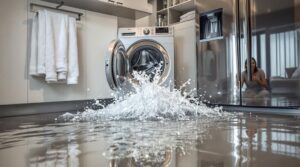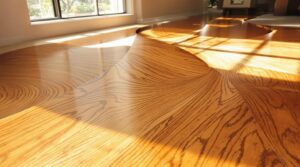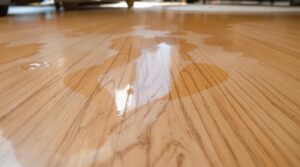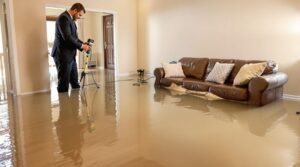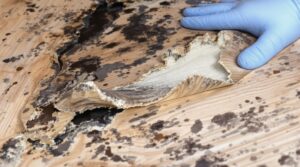Water damage on hardwood floors exhibits several distinctive indicators. Common signs include warping, cupping, and buckling of floorboards where edges rise higher than centers. Dark spots, discoloration patterns, and mineral deposit rings often appear on affected surfaces. Property owners may notice spongy or soft areas when walking, along with lifting nails and musty odors suggesting potential mold growth. Understanding these warning signs enables rapid response and prevention of further structural deterioration.
Key Takeaways
- Cupping and buckling of floorboards where edges rise higher than centers, creating an uneven surface across the hardwood floor.
- Dark spots, cloudy patches, and discoloration patterns appear on the wood surface, indicating water penetration and damage.
- Musty odors and visible mold growth suggest hidden moisture problems beneath or within the hardwood flooring.
- Soft, spongy areas when walking across the floor indicate compromised wood structure and potential subfloor damage.
- Lifting nails, separating boards, and visible warping show water has affected the floor's structural integrity.
Understanding Common Signs of Water Damage
Numerous telltale signs can indicate water damage on hardwood floors, ranging from visible surface alterations to subtle structural changes beneath the floorboards. Common indicators include warping, cupping, and buckling of the wood, where boards may lift at the edges or develop an uneven surface.
Discoloration patterns, such as dark spots or cloudy patches, often emerge as moisture penetrates the wood fibers. A spongy or soft feeling when walking across affected areas can signal potential deterioration of the subfloor.
Professional moisture detection methods can reveal hidden damage before it becomes visible. Signs like lifting nails, soft spots, or a musty odor may indicate underlying issues requiring immediate flooring maintenance.
The severity of these symptoms typically correlates with exposure duration and water type, whether from clean, gray, or blackwater sources. Early identification of these signs is essential for preventing extensive damage and maintaining structural integrity.
Visual Indicators of Moisture Problems
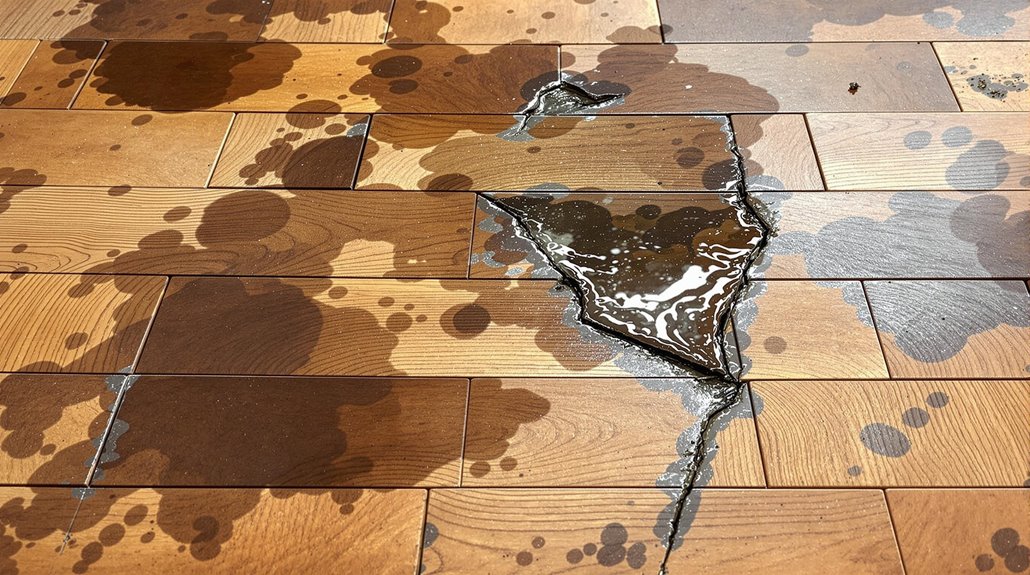
Identifying early warning signs of moisture damage in hardwood floors requires careful observation of both subtle and obvious visual indicators.
Surface changes often manifest as discoloration, warping, or persistent condensation without a clear source.
A strong musty odor usually indicates hidden moisture problems that need investigation.
Stains and splotchy appearances on floorboards, combined with visible deformation or cupping of the wood, serve as critical indicators that moisture problems require immediate attention.
Early Warning Signs
When moisture infiltrates hardwood flooring, distinct visual indicators emerge that signal potential water damage. These early symptoms require immediate moisture detection to prevent extensive deterioration.
The most common signs include cupping, where board edges rise higher than centers, and crowning, characterized by swollen board centers with receding edges. Wood preservation becomes critical when signs of warping or buckling appear, as boards begin to shift and misalign from their original position. Dark spots and discoloration are telltale warning signs that water has penetrated the wood surface.
Additional indicators include the presence of musty odors, suggesting mold or mildew growth beneath the surface, and persistent water condensation without an apparent source.
Professional assessment should be sought when these warning signs appear, as early intervention can prevent costly structural damage and maintain the floor's integrity.
Surface Changes and Stains
Visual evidence of moisture damage in hardwood floors manifests through distinct surface alterations and staining patterns. Notable indicators include surface warping, where floorboards become raised, deformed, or buckled due to water absorption.
Cupping and humping of boards create uneven surfaces that can trap additional moisture, exacerbating the problem.
Discoloration patterns present in various forms, from dark spots and black staining to white streaks and rings caused by mineral deposits. These stains often result from trapped moisture at both surface and subfloor levels.
The wood's grain may display altered appearances, while continuous humidity exposure can lead to persistent discoloration.
Within 24 hours of water exposure, mold growth may appear in green, black, or white patches, accompanied by musty odors that signal ongoing moisture issues.
Immediate Steps to Take When Water Damage Is Spotted

Quick response time is essential when water damage is discovered on hardwood floors. The first immediate actions involve stopping the water source by shutting off the main supply and addressing any broken pipes or appliances causing the leakage.
Emergency response should focus on removing standing water using wet/dry vacuums and absorbent materials.
Once the excess water is removed, proper drying techniques must be implemented. Deploy fans and dehumidifiers strategically around the affected area while ensuring adequate air circulation through open windows and doors.
Avoid using heat during the drying process, as it can cause additional warping. Throughout this process, assess the extent of damage using moisture meters and check for signs of buckling or discoloration.
This assessment will determine whether professional intervention is necessary for more severe cases.
Long-Term Effects of Water Exposure on Hardwood
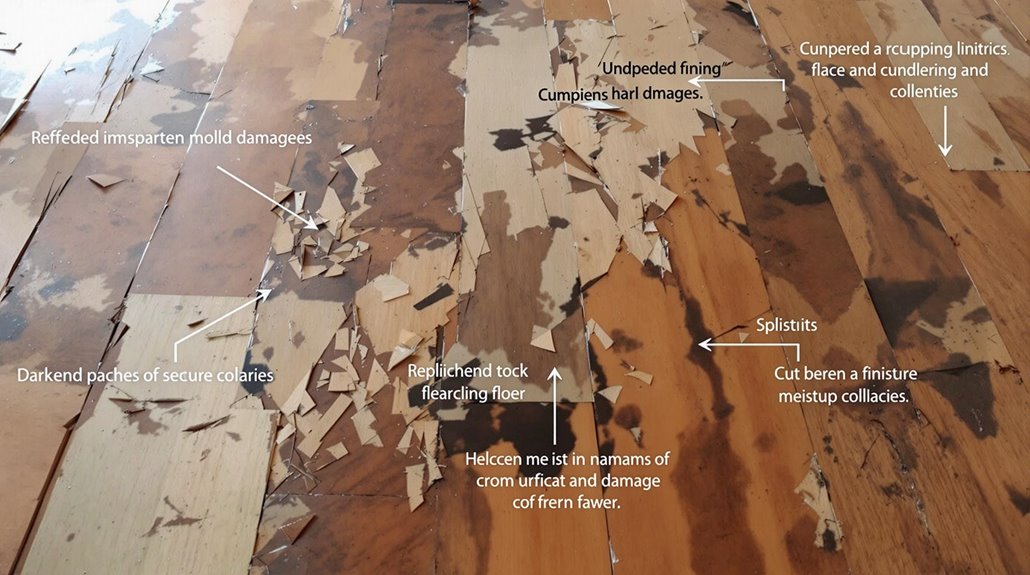
Water exposure inflicts progressive deterioration on hardwood flooring, affecting both surface integrity and internal wood cell structures at a microscopic level.
Hidden mold colonies can develop within and beneath the boards, compromising structural stability while simultaneously creating potential health hazards.
The cumulative effects of moisture penetration often manifest in permanent cellular damage to the wood fibers, leading to irreversible warping, splitting, and loss of structural cohesion.
Structural Integrity Over Time
Long-term exposure to moisture poses severe consequences for hardwood flooring's structural integrity. Without proper structural reinforcement and moisture barriers, water absorption leads to significant deterioration, manifesting in various forms of deformation.
The wood's natural tendency to absorb moisture results in warping, buckling, and permanent damage to the material's cellular structure. As water penetrates the wood fibers, two primary distortion patterns emerge: cupping, where edges rise above the center, and crowning, where the center elevates above the edges.
These deformations indicate progressive weakening of the wood's internal structure. The compromised integrity makes the flooring increasingly susceptible to damage from routine activities, ultimately necessitating either partial replacement of affected sections or complete floor restoration, depending on damage severity.
Hidden Mold Growth Issues
Hidden beneath the surface of water-damaged hardwood floors, mold colonies can develop and proliferate, creating serious health hazards for building occupants.
The presence of mold often manifests through persistent musty odors, visible discoloration, and warping of wood planks. These indicators suggest underlying moisture control issues that require immediate attention.
Exposure to hidden mold growth poses significant mold health risks, including respiratory problems, allergic reactions, and potential mycotoxin exposure.
The combination of high humidity levels, poor ventilation, and trapped moisture creates ideal conditions for mold development beneath flooring materials.
Regular inspection of hardwood surfaces for signs of water damage, coupled with proper ventilation and swift remediation of water intrusion, is essential for preventing extensive mold colonization and maintaining a healthy indoor environment.
Permanent Wood Cell Damage
Prolonged exposure to moisture triggers irreversible cellular deterioration in hardwood flooring materials, fundamentally altering their structural composition and mechanical properties. The damage occurs as water penetrates through pits in the cell wall, disrupting the wood's natural moisture retention mechanisms and leading to excessive expansion.
While wood exhibits elastic properties initially, continuous water exposure eventually causes permanent alterations at the cellular level. This degradation manifests through multiple physical changes, including swelling beyond 75 percent of original dimensions, severe cupping, and structural weakening.
The compromised cell wall structure results in brittleness, making the wood susceptible to cracking and splintering under normal use. These cellular changes also affect the wood's aesthetic properties, causing persistent discoloration and staining that ranges from light brown to deep black tones.
Professional Assessment and Restoration Options
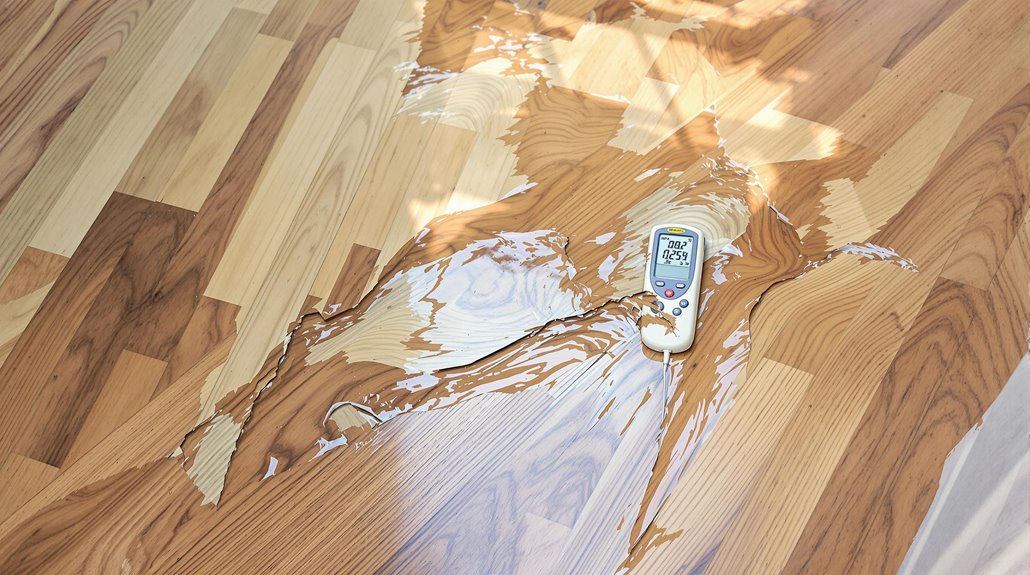
When water damage affects hardwood flooring, professional assessment and restoration services become essential to evaluate the extent of damage and implement appropriate recovery measures.
Specialists utilize advanced moisture meters, thorough damage assessments, and specialized diagnostic tools to identify visible and hidden issues, including structural concerns and moisture content levels.
Professional restoration techniques typically follow a systematic approach, beginning with water extraction and proceeding through drying, dehumidification, cleaning, and sanitization.
For minor damage, light sanding and refinishing may suffice, while severe cases might require board replacement.
The process also addresses special considerations such as mold growth and engineered wood specifications.
These professional interventions aim to restore both the appearance and structural integrity of the flooring while implementing preventive measures against future water damage.
Prevention Strategies for Protecting Your Floors

To effectively protect hardwood floors from water damage, implementing extensive prevention strategies is essential across multiple phases, from pre-installation through long-term maintenance.
Initial preventative measures include installing proper moisture barriers and damp-proof membranes, alongside thorough inspections for potential leaks and moisture sources.
Daily maintenance protocols require immediate spill removal, use of appropriate cleaning products, and controlled moisture cleaning methods.
High-risk areas demand additional protection through strategic placement of rugs and mats, coupled with enhanced sealant applications.
Long-term strategies focus on maintaining ideal indoor humidity levels between 30-50% through dehumidifiers, regular plumbing inspections, and systematic floor maintenance.
These thorough approaches, when properly executed, greatly reduce the risk of water damage while preserving the integrity of hardwood flooring.
The Benefits Of Consulting A Public Adjuster
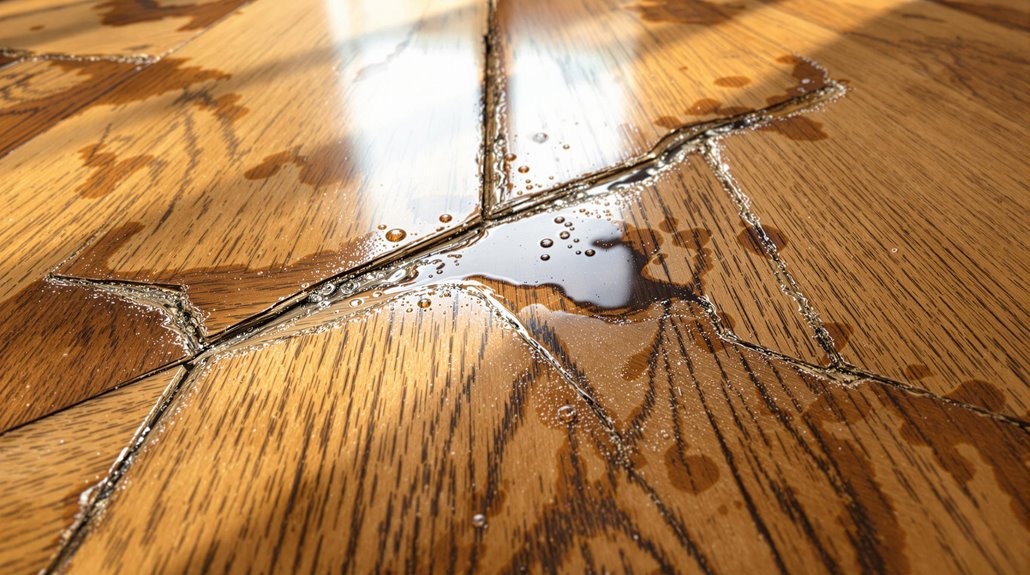
When faced with water damage to hardwood floors, consulting a public adjuster provides critical expertise in maneuvering complex insurance claims and securing fair compensation.
Public adjusters conduct thorough, objective assessments of water damage using specialized equipment, documenting both visible deterioration and hidden moisture issues that could lead to future problems.
Their professional management of the claims process not only streamlines documentation and negotiations with insurance companies but typically results in higher settlement amounts due to their extensive understanding of policy coverage and accurate damage valuation.
Studies show that working with licensed public adjusters can increase settlement amounts up to 500% for non-catastrophic claims like water damage.
Expertise In Insurance Claims
Steering insurance claims for water-damaged hardwood floors requires specialized expertise that public adjusters can provide. These professionals possess extensive knowledge of insurance policy terms, interpretations, and the intricate claims process. Their understanding of policy language enables them to identify all applicable coverage and guarantee maximum entitlements for floor damage restoration.
Public adjusters maintain current knowledge of insurance regulations and procedural requirements, helping property owners navigate complex claim submissions. They meticulously document water damage through detailed assessments, photographs, and supporting evidence.
Their expertise extends to preparing thorough proof of loss statements and managing all necessary paperwork. Through their thorough understanding of insurance company practices, public adjusters effectively negotiate settlements while guaranteeing compliance with policy terms and regulatory standards. Unlike insurance adjusters who work for carriers, public adjuster fees are based on a percentage of the final settlement amount, typically up to 10% of the total claim payout.
Objective Damage Assessment
The thorough assessment of water-damaged hardwood floors demands the specialized expertise of public adjusters, who utilize advanced diagnostic tools and methodologies to identify both visible and concealed damage.
Their extensive water detection techniques, including moisture meters and thermal imaging, uncover hidden issues like seepage beneath floorboards and potential mold growth.
During damage evaluation, public adjusters meticulously document all affected areas, providing detailed insights into the restoration timeline and associated costs.
This objective assessment guarantees that insurance claims accurately reflect the full scope of damage, including secondary effects that may not be immediately apparent.
Their professional evaluation serves as a critical foundation for fair compensation, as they catalog every aspect of the damage while maintaining an impartial stance throughout the documentation process.
Like with roof damage claims, sudden and accidental water damage must be thoroughly documented with photographs and written descriptions to support successful insurance claims.
Streamlined Claim Process
Public adjusters streamline the insurance claims process through thorough management of documentation, communication, and negotiations. They handle all paperwork with professional accuracy while maintaining extensive records of interactions and progress. This systematic approach expedites claim resolution and prevents common pitfalls.
Their specialized knowledge of insurance policies and procedures enables efficient navigation of complex claims requirements. Public adjusters conduct thorough damage assessments, identify all relevant losses, and utilize their expertise in insurance negotiations to secure fair compensation.
They serve as advocates, managing all communications with insurance companies while keeping property owners informed of claim progress. This professional representation allows property owners to focus on recovery while ensuring their interests are protected throughout the claims process.
Higher Claim Payouts & Settlements
Building upon the efficiency of streamlined claims management, professional representation by public adjusters consistently yields higher settlement amounts for property owners with water-damaged hardwood floors.
Through strategic claim negotiation and expert settlement strategies, public adjusters leverage their extensive knowledge of insurance policies and damage assessment to maximize compensation.
Key factors contributing to increased claim settlements include:
- Thorough documentation using advanced moisture detection and thermal imaging technology
- Expert interpretation of policy coverage and entitlements
- Professional advocacy during negotiations, removing emotional bias from discussions
- Contingency-based representation that aligns the adjuster's interests with maximizing payouts
Public adjusters' professional expertise in identifying both visible and concealed damage, combined with their understanding of restoration costs, enables them to secure settlements that more accurately reflect the true extent of hardwood floor water damage.
With an average of annual adjuster salary of $61,465, these professionals invest significant time and expertise into securing optimal claim outcomes for their clients.
About The Public Claims Adjusters Network (PCAN)
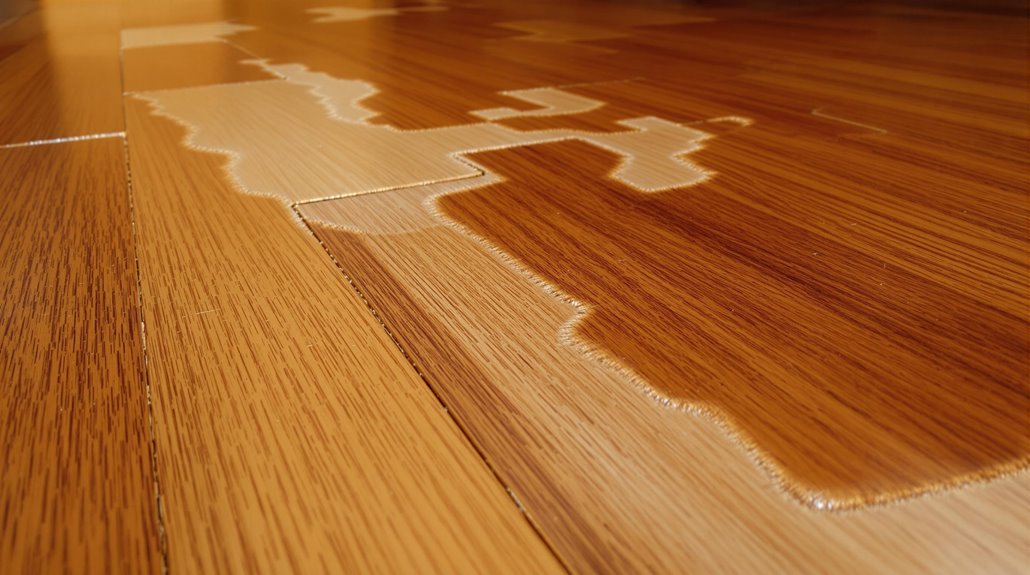
Professional adjusters within the Public Claims Adjusters Network (PCAN) form a thorough alliance of licensed experts dedicated to advocating for policyholders during insurance claims processes. Their all-encompassing approach guarantees ideal outcomes through systematic assessment and negotiation strategies. Public adjuster fees typically range from 5% to 15% of total claim settlements.
| Service Area | Expertise | Client Benefits |
|---|---|---|
| Policy Review | Coverage Analysis | Maximum Protection |
| Damage Assessment | Cost Evaluation | Accurate Valuation |
| Claims Filing | Documentation | Complete Submission |
| Settlement Negotiation | Market Knowledge | Fair Compensation |
| Client Representation | Legal Compliance | Professional Support |
PCAN members maintain rigorous professional standards while providing specialized claims advocacy services across multiple jurisdictions. Their global network leverages collective expertise in construction costs, policy interpretation, and settlement negotiations to deliver customized solutions for various property damage scenarios, including water-damaged hardwood floors.
Frequently Asked Questions
How Long Can Hardwood Floors Remain Wet Before Permanent Damage Occurs?
Hardwood floors can sustain permanent damage within 24 hours of water exposure, with moisture retention escalating rapidly. Professional drying techniques must be implemented immediately to prevent irreversible structural deterioration and warping.
Can Water-Damaged Hardwood Floors Be Partially Replaced Instead of Completely?
Partial replacement is feasible for water-damaged hardwood floors when damage is localized and conditions are favorable. Professional flooring restoration can effectively integrate new boards with existing flooring for seamless results.
Does Homeowner's Insurance Typically Cover Water Damage to Hardwood Floors?
Homeowner's insurance typically covers sudden water damage to hardwood floors from burst pipes or appliance failures, while excluding gradual deterioration. Coverage depends on specific insurance policies and damage source determination.
What's the Average Cost to Repair Water-Damaged Hardwood Flooring?
Repair costs for water-damaged hardwood flooring range from $10-$80 per square foot, with average flooring restoration projects totaling $500-$1,500 for minor damage and $5,000-$15,000 for extensive repairs.
How Can You Tell if Water Damage Came From Above or Below?
Moisture source assessment relies on damage patterns: crowning indicates water from above, while cupping suggests below-source damage. Professional damage assessment evaluates board deformation and moisture content distribution for accurate determination.
References
- https://jenkinsrestorations.com/how-to-minimize-and-repair-water-damage-to-wood-floors/
- https://www.steamyconcepts.com/blog/2023/09/01/water-damage-on-wood-floors-types-of-damage-restoration/
- https://romerohardwoodfloor.com/how-to-repair-a-water-damaged-hardwood-floor/
- https://dryforcecorp.com/4-signs-of-water-damage-on-wood-floors/
- https://www.fromtheforest.com/blogs/fromtheforest/signs-that-your-wood-floors-are-water-damaged
- https://www.bobvila.com/articles/signs-of-water-damage-under-floor/
- https://preferred-flooring.com/blog/4-signs-your-wood-floor-has-water-damage/
- https://www.servicemasterrestore.com/servicemaster-by-cornerstone/why-us/blog/2024/december/common-signs-of-water-damaged-floors-and-how-to-address-them/
- https://www.delmhorst.com/blog/hardwood-floor-moisture-warning-signs-to-look-out-for
- https://www.delmhorst.com/blog/what-are-safe-moisture-levels-for-hardwood-floors
